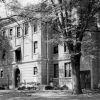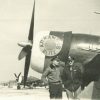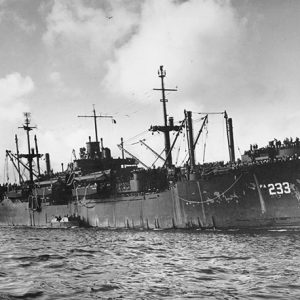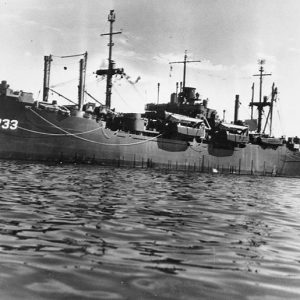calsfoundation@cals.org
USS Sevier (APA-233)
The USS Sevier (APA-233) was a 6,720-ton Haskell-class attack transport built in 1944 and named for counties in three states, including Arkansas.
The Kaiser Company of Vancouver, Washington, laid down the hull for the USS Sevier on October 4, 1944, under a contract with the Maritime Commission. It launched on November 16, 1944. The Sevier was commissioned on December 5, 1944, under Captain A. R. Ponto. The ship was 455 feet long and 62 feet wide and could reach speeds of 17.7 knots. It had a crew of fifty-six officers and 490 sailors and could carry up to eighty-six officers and 1,440 men. The Sevier was armed with one 5-inch gun, one quad-40mm antiaircraft mount, four twin 40mm guns, and ten single-mount 20-mm AA guns.
The USS Sevier had shakedown cruise (a test of the ship’s performance) at San Pedro, California, between December 27, 1944, and January 26, 1945, before heading for Pearl Harbor on February 6. After training there, the vessel steamed to Eniwetok on February 28, joining a convoy headed to Iwo Jima. It anchored off Iwo Jima on March 14, taking aboard a load of Fourth Division U.S. Marines who were delivered at Maui on April 5. Following repairs at Pearl Harbor, the Sevier embarked 1,193 men of the 125th Construction Battalion and 171 marines, and left on May 12. Laying over at Ulithi until June 13, the Sevier dropped the Seabees and marines off at Okinawa between June 17 and 19.
Returning to the United States on July 13, the Sevier had its propeller shaft repaired before arriving back at Pearl Harbor on August 7, 1945. Following Japan’s capitulation, the ship brought several loads of occupation troops to Sasebo before taking part in Operation Magic Carpet, dropping off victorious American veterans at San Francisco, California, on November 10. The Sevier returned to the Far East in late November to load more veteran troops, who were brought to Seattle on December 29. The vessel made several other trips supporting occupation activities in Japan.
On May 28, 1946, the Sevier left Pearl Harbor to evacuate U.S. personnel from the Bikini Islands prior to atomic bomb tests there. After another run to the United States, the Sevier sailed to Chinese ports from October 1946 to January 1947. Sailing back to the United States, the Sevier was decommissioned at Suisun Bay, California, on April 30, 1947, and placed in the Maritime Commission’s National Defense Reserve Fleet, having won two battle stars for World War II service.
Struck from the navy list on June 23, 1947, the USS Sevier was re-designated as an amphibious transport (LPA-233) on January 1, 1969, still part of the defense fleet. It and four other former attack transports were sold to the Mormoc SS Corporation on February 15, 1980. The Sevier was taken from American waters on April 14, 1980, and scrapped by the Kang Hua Enterprises Company of Taiwan. Its demolition was completed by July 22, 1980.
For additional information:
“Sevier.” Dictionary of American Fighting Ships. https://www.hazegray.org/danfs/amphib/apa233.txt (accessed July 13, 2018).
“USS Sevier (LPA-233).” NavSource.org. found at http://www.navsource.org/archives/10/03/03233.htm (accessed July 13, 2018).
Mark K. Christ
Little Rock, Arkansas
 Military
Military Sevier County
Sevier County World War II
World War II World War II through the Faubus Era, 1941 through 1967
World War II through the Faubus Era, 1941 through 1967 USS Sevier
USS Sevier  USS Sevier
USS Sevier 




Comments
No comments on this entry yet.